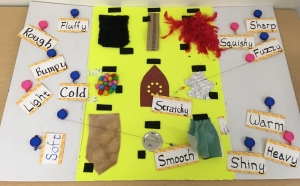
Textures table: In previous years, we set up a wide variety of objects for children to explore. Ideas: fur, fake fur, feathers, bubble wrap, pine needles, wool, and sand paper. I found a collection of balls that all felt different: nubbly, smooth, hard, soft, squish, cold, warm.
This year, we made a “sensory board“. Click on that link to learn about it, or check Pinterest for LOTS more ideas.

Texture gradients: Get several different grades of sandpaper. Have children put them in order from roughest to smoothest.
Sanding Wood: You could then have them use sandpaper to sand rough wood to smooth.
Tactominoes: These dominoes were in our classroom. I can’t find them to buy online – it looks like they might be from Discovery Toys in the 1990s. You could make something like them… In each circle, there’s different textures: sandpaper, corrugated cardboard, fuzzy felt, smooth plastic and so on.
Sensory bowls: You could fill several bowls with different sensory materials (rice, pinto beans, split peas, and so on) and have kids plunge a whole hand in and describe what they feel, then try another bowl and describe how it’s similar or different.
Temperature: Explore temperature sensations by putting their hands in warm water and ice water. Or wrapping their hands around a metal container with ice water in it, and a coffee cup full of hot water. This would also offer an opportunity for a safety talk – when you think something might be hot, approach it slow and cautiously so your sensors can warn you if it’s too hot to touch!
Braille: In our classroom, we had some great resources we just weren’t able to fit into our one day on the senses. We have braille alphabet cards and a braille children’s magazine and more that would have been a fun texture exploration, but also an opportunity for education.
Art Projects
Crayon rubbings. You can tape any textured but relatively flat object on the table, then kids can lay paper over it and do a rubbing.
Texture Collage. Gather a wide variety of interesting textured materials, and let them design their own collage.
Feely Book: You could staple together some card stock and they could create their own
Pat the Bunny style book. (Put lots of sample books on the table, with a wide variety of textured materials (sand paper, fake fur, feathers….)
Guided Activities for Group Time or One-on-One
Identify the texture: You could blindfold a child, have them feel something, then guess what it was. Or you could use your feely box, have one child reach in, touch an object, describe it and see if anyone can guess what object it is. (With younger children, you’d first want to show them a collection of objects before putting them in because it would give kids a better sense of what they might find in there
Can only your hands feel things? When we teach about touch, it’s easy to create a misconception that only our hands feel things (especially because only our noses smell, only our tongues taste, only our ears hear and only our eyes see.) Talk about this with kids, then demo it: can you feel when I touch your head? when I tickle your tummy? when you eat food, can you feel it on your tongue? when you get something in your eye, can you feel it? You could play a game of placing an object on the child’s back and having them guess what it is.
Our sense of touch protects us: Our sense of touch tells us that things are really hot so we know not to touch them and get burned. If we lightly touch a knife blade, touch warns us it’s sharp so we know to move our hand away, not press against it. When we climb up stairs, touch tells us when our foot has reached the next stair, so we can adjust the way we are moving our muscles so we don’t fall. If we couldn’t feel things it would be very easy to get hurt.
Outdoors
Gather textures: On our outdoor hike, we asked them to touch a wide variety of things: rough Douglas fir, fuzzy red cedar, soft moss, serrated sword fern leaves, sharp holly, and so on. They gathered items from the forest floor that were interesting textures in a basket – lots of pine cones, some sticks, some dead leaves, and we took those back into the classroom to talk about more.
I suspect you could make up a good song about “going on a texture hunt… gonna find a rough one….”
More Info: You can find an overview of the five senses and reviews of lots of great kids’ non-fiction books about the senses at https://inventorsoftomorrow.com/2017/03/17/5-senses-2/
There’s lots more great ideas on Neuroscience for Kids.




[…] Touch – Science for Kids […]
LikeLike
[…] Touch – Science for Kids […]
LikeLike
Love this!
LikeLike
[…] Five Senses Unit: Overview, Hearing, Vision, Touch, Taste, Smell […]
LikeLike
[…] Five Senses Unit: Overview, Hearing, Vision, Touch, Taste, Smell […]
LikeLike
[…] reach in and feel something, but can’t see it. Put in several interesting textures. (Details here.) Or, make a board with several textures to […]
LikeLike
[…] Touchy Feely – throw random objects in a pillow case. Have child reach in, pick one up, guess what it is, then pull it out to check their guess. […]
LikeLike
[…] our Five Senses unit on Touch, my co-teacher developed this touchy-feely board that included: fake fur, sandpaper, prickly […]
LikeLike
[…] reach in and feel something, but can’t see it. Put in several interesting textures. (Details here.) Or, make a board with several textures to […]
LikeLike